‘This is our land’: Native Americans see Trump’s move to reduce Bears Ears monument as an assault on their culture
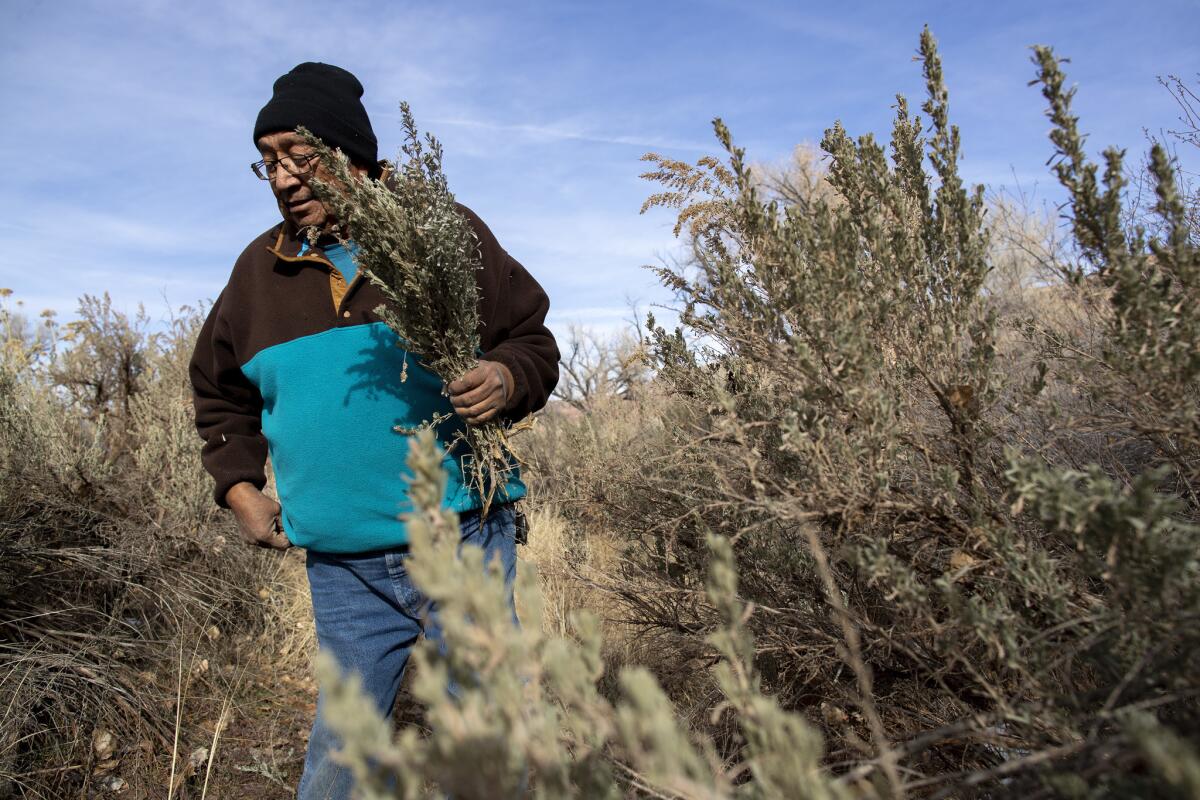
- Share via
SAN JUAN COUNTY, Utah—Thick red mud clung to Jonah Yellowman’s boots as he sidestepped down the embankment into a narrow valley of sagebrush. When he spotted perfect stems — not too dry, not too long — he snapped them from the waist-high bushes.
Every few months for much of his life, the 66-year-old Navajo spiritual leader has trekked from his nearby home to this slice of land in southeastern Utah, not far from the base of the Bears Ears buttes, to gather sage. Throughout the year, he uses the plant in ceremonies, often sharing it with people seeking wisdom or health, or as a way to offer thanks.
“This is our land and our herb,” Yellowman said. “It has to be protected. It’s all we have.”
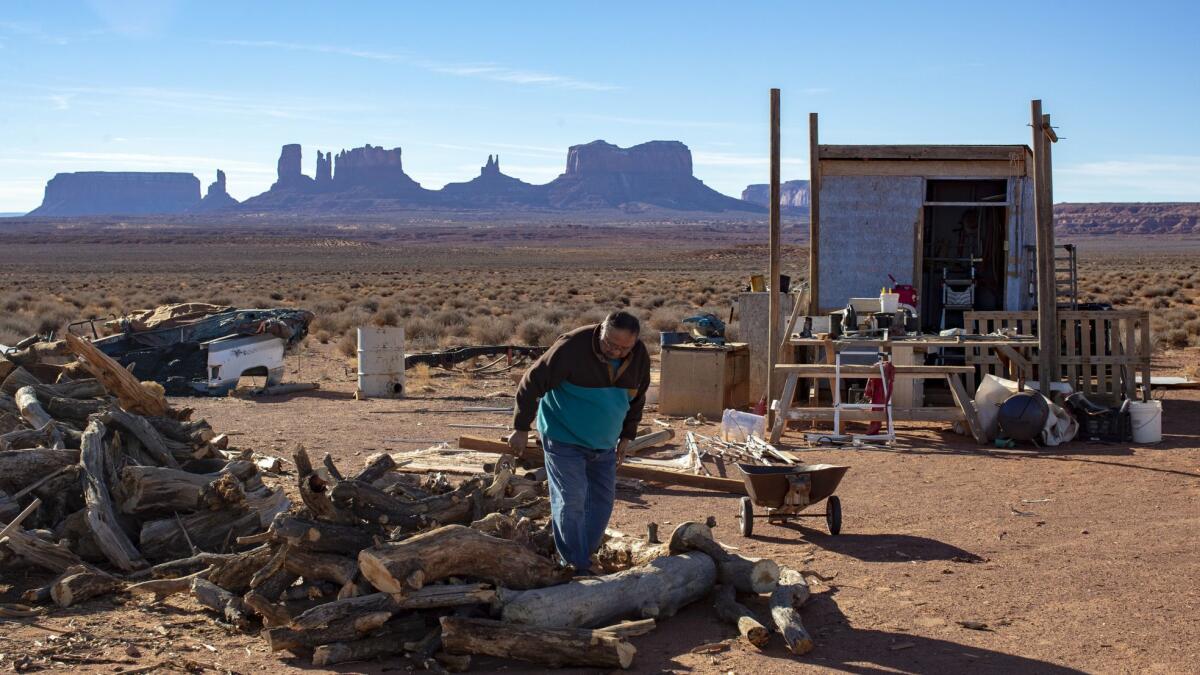
Last year, President Trump signed proclamations slashing the size of Bears Ears National Monument by 85% and neighboring Grand Staircase-Escalante by about half, the largest combined rollback of federally protected land in the nation’s history.
With several lawsuits set to be decided early next year, the decision — a recommendation by outgoing Interior Secretary Ryan Zinke, whose short tenure included opening millions of acres of public land for drilling — struck critics as a clear example of what they characterize as a larger attack on indigenous communities. The scaling back of Bears Ears, they say, feels especially targeted, since it was a coalition of tribes that had lobbied to have the land designated as a national monument.
In December 2016, President Obama signed a proclamation protecting 1.35 million acres of land as part of the newly created Bears Ears National Monument, named for the distinctive buttes that resemble a bear peering over the horizon.
“The land,” Obama’s proclamation read, “is profoundly sacred to many Native American tribes.”
So a year later, when Trump opted to shrink the monument to about 200,000 acres, potentially opening hundreds of thousands of acres to mining operations, many tribes took it as an affront.
Of the nation’s nearly 130 national monuments, Bears Ears was the first one that Native American tribes had proposed and fought for, said Natalie Landreth, an attorney representing several tribes that have filed suit to reverse Trump’s action.
“This is the first monument Trump attacks,” Landreth said. “That is no coincidence — it’s a direct assault on the exercise of tribal sovereignty that resulted in the monument, and an assault on the cultures the tribes are trying so desperately to protect.”
In court filings, the Hopi, Pueblo of Zuni, Ute Indian and Ute Mountain Ute tribes, as well as the Navajo Nation and several environmental groups, assert that Trump does not have the power to shrink Bears Ears. The Antiquities Act, they say, grants the president the authority to create national monuments, but not to rescind or reduce them.
Shrinking the monument, the suits argue, would threaten hundreds of historical rock art panels, artifacts and kivas. Other presidents have made adjustments to national monuments, the last major reduction coming when Woodrow Wilson cut Mount Olympus National Monument — currently a national park — by almost half in 1915. But until now, no reduction has been challenged in court.
Under Trump’s downsizing, the symbolic buttes, as well as some cliff dwellings, remain protected land. But much of the land that was a part of the original monument is now unprotected.
While legal back-and-forths play out in courtrooms in Washington, D.C., Yellowman and other Native Americans here wonder about what lies ahead: Will their grandchildren gather juniper and pine along the red rock mesas? Will there still be sage?
“I always think about the land,” Yellowman said, snapping stems and clutching them like a bouquet. “Will it be here for my people?”
Yellowman’s great-great-great grandmother was born on the eastern butte. Family members told him that her cradleboard, a traditional way to carry babies, was made from the pine trees on the butte. In the 1860s, Yellowman said, the U.S. government drove his ancestors from the buttes and later marched them to Fort Sumner, N.M., where they were imprisoned, part of a forced journey known as the Long Walk.
As a boy, Yellowman, who was born on a mesa in the northern part of the Navajo Nation reservation, often traveled with brothers and cousins to Cedar Mesa, a plateau near the base of the buttes, to chop and gather firewood.
He recalled driving past a uranium-ore processing mill one year that a Texas-based company had built on land leased from the Navajo Nation. It left him unsettled, especially as family members who worked in the mill began to fall ill and die. Today, toxic debris from the mill, which closed in the late 1960s, still litters the land.
On a recent afternoon, Yellowman walked along the acre of land where he lives on the reservation. The towering red rock spires of Utah’s Monument Valley formed outlines like skyscrapers on the horizon and several abandoned cars line the property.
He headed to a massive woodpile and cradled several pieces of cedar before walking up the stairs of his single-level home. Yellowman doesn’t have running water or electricity, instead relying on 5-gallon jugs he fills with water at a nearby well and a wood-burning stove that heats the living room.
“I’ve used this wood my whole life,” Yellowman said, placing a log into the stove. “It gives me warmth and life. I fear that one day it won’t be here for others like me — that the land will just evaporate because of mining and drilling.”
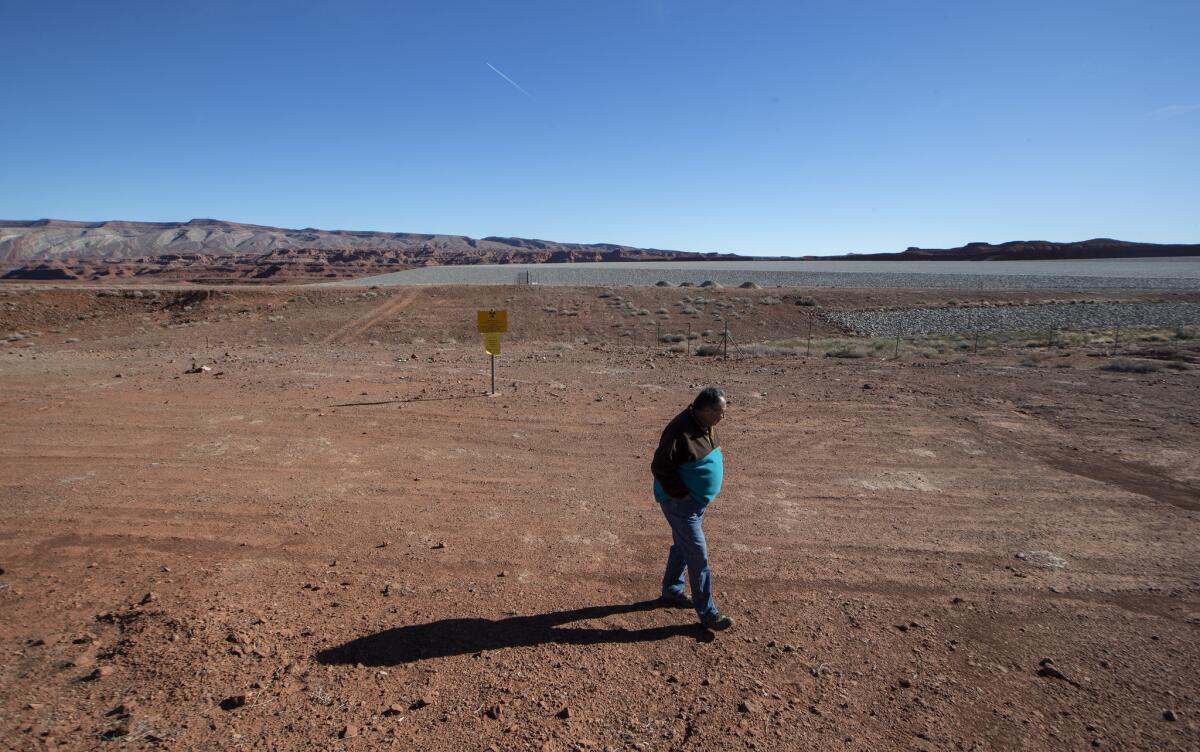
The nation’s sole uranium-processing mill sits along the eastern boundary of the original monument. Documents obtained last year by the Washington Post show that Energy Fuels Resources (USA) Inc. urged the Trump administration to reduce the size of the monument, making it easier for the company to access radioactive ore.
In a May 2017 letter, the company’s chief executive, Mark Chalmers, wrote that the monument “could affect existing and future mill operations.”
“There are also many other known uranium and vanadium deposits located within the [original boundaries] that could provide valuable energy and mineral resources in the future,” he wrote.
A spokesman for Energy Fuels said the company played only a small role in the downsizing of the monument and had no plans to mine or explore the land within the original boundaries of the monument.
Even if they did want to mine the area, some argue that it would be futile.
“There is nothing there to mine,” said Rep. John Curtis, a Republican who represents Utah’s San Juan County in Congress.
To Curtis, Obama’s actions were a federal land grab — a misuse of the Antiquities Act and an infringement on Utah’s rights. Last year, he introduced a bill that would codify Trump’s cuts to the monument, but also ban further drilling or mining within the original boundaries. So far, it’s stalled in Congress.
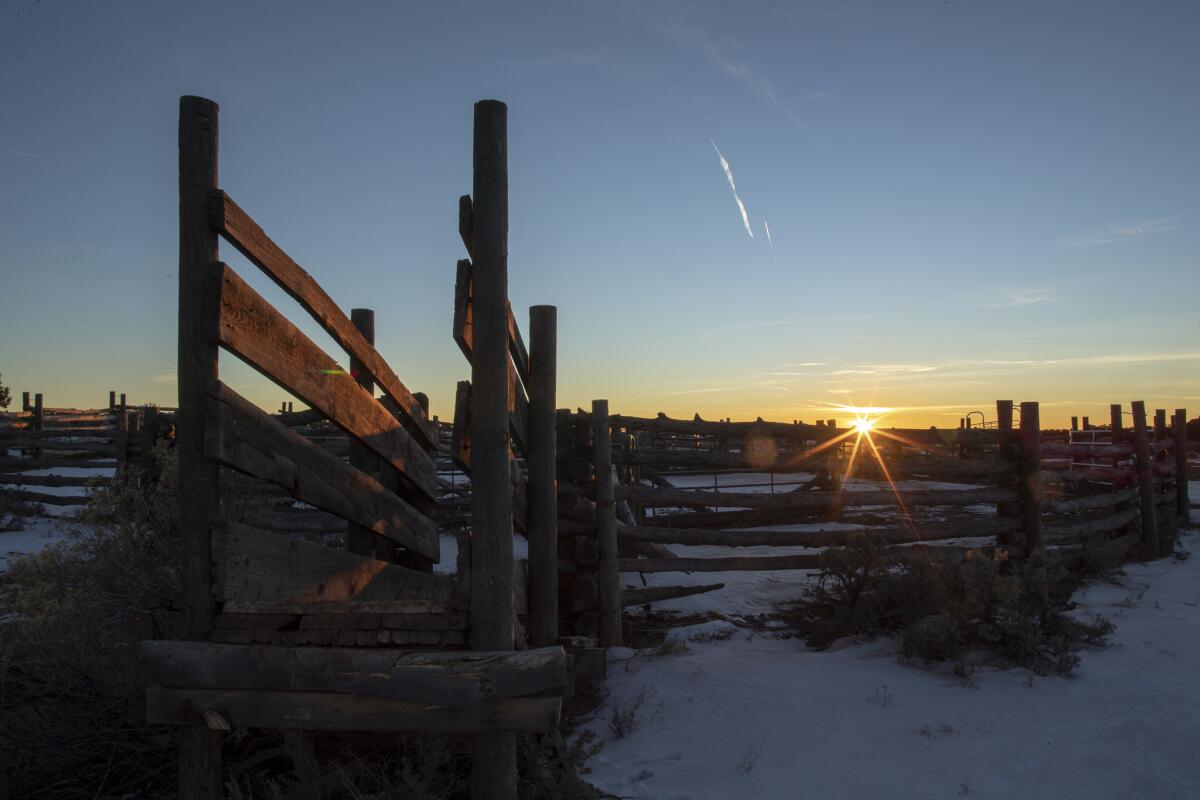
Some Native Americans and activists see Trump’s scaling back of Bears Ears as part of a larger pattern of attacking indigenous communities, such as his decision to override the protests of tribal members and advance the Dakota Access Pipeline project near the Standing Rock Indian Reservation in the Dakotas.
Angelo Baca, a cultural resources coordinator with Utah Diné Bikéyah, a group that works with indigenous communities to protect culturally significant ancestral lands and has filed a lawsuit against the Trump administration, said efforts to undo Obama’s directive are “tantamount to disrespect for land and people.”
“What we do to the land, we do to ourselves,” said Baca, who is Navajo and grew up in San Juan County. “We need leadership that understands such connections and respects them, but we need everyday people in this country to understand it even more, for they are more powerful than one leader could ever be.”
The group, which Yellowman works with, contributed to more than 200,000 public comments submitted to the Bureau of Land Management, asking it to halt planning of the newly designed Bears Ears until the lawsuits can be heard.
Locally, the political fallout has been swift. Since Trump’s announcement, two of the three county commissioners who supported the reduction have been replaced by candidates — both Navajo — who staunchly oppose the downsizing. It’s the first time Native Americans, who make up nearly half of the county’s population, have held a majority on the commission.
Harrison Rock, 29, a clerk at the lone gas station in Mexican Hat, Utah, a town named after a nearby boulder that resembles a sombrero, said the monument reduction was an attack on Native Americans.
“Trump continues to attack people of color, and this is an attack that could have lasting impact,” said Rock, who is Navajo. A patron at the counter waiting to pay for gas nodded in support.
“This country has hurt my people. And it continues to do so,” Rock said.
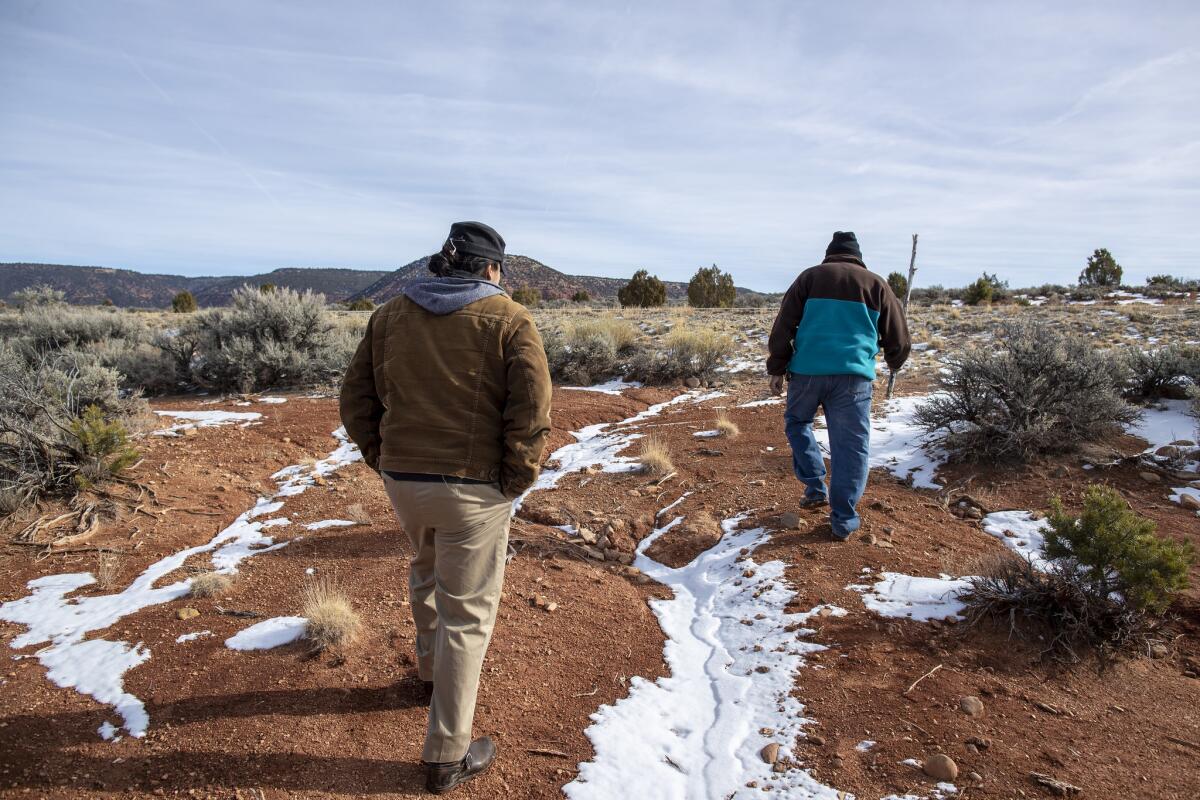
On a recent afternoon, Yellowman walked through Cedar Mesa in search of juniper branches. He needed to make a coal poker — honeeshgish in Navajo — for a ceremony he was set to oversee the next day. It was biting cold, and there were patches of snow at the base of what seemed like an endless blanket of towering juniper. Sweat lodges and hogans once dotted the terrain, Yellowman said. Some still exist, he said, but are now hidden from the public.
“This is a place where we can come together and have respect for one another, have respect for nature, have respect for the past,” he said. “We’re all trying to heal … this land — Cedar Mesa, Bears Ears — is our medicine.”
Twitter: @kurtisalee
Sign up for Essential California
The most important California stories and recommendations in your inbox every morning.
You may occasionally receive promotional content from the Los Angeles Times.








